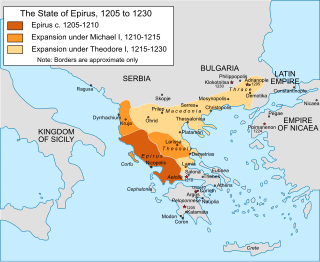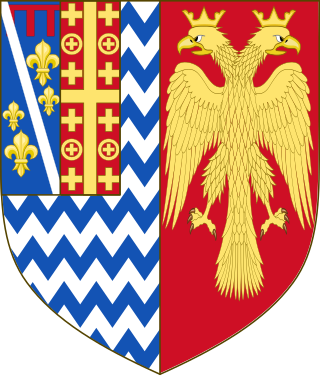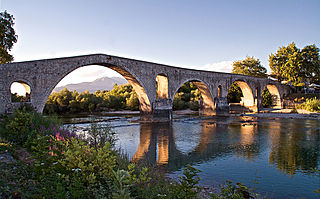
The Despotate of Epirus was one of the Greek successor states of the Byzantine Empire established in the aftermath of the Fourth Crusade in 1204 by a branch of the Angelos dynasty. It claimed to be the legitimate successor of the Byzantine Empire, along with the Empire of Nicaea and the Empire of Trebizond, its rulers briefly proclaiming themselves as Emperors in 1227–1242. The term "Despotate of Epirus" is, like "Byzantine Empire" itself, a modern historiographic convention and not a name in use at the time.

The despot of Epirus was the ruler of the Despotate of Epirus, one of the successor states of the Byzantine Empire in the aftermath of the Fourth Crusade. The name "Despotate of Epirus" and the title "despot of Epirus" are modern historiographical names, and were not in use by the despots themselves. In the Byzantine Empire, the title of despot was a prestigious court title and did not designate rule over some specific territory. Though several of the early Greek rulers of the Epirote realm did use the title of despot, it was never in reference to the lands they governed, but instead in reference to their position in the imperial hierarchy.

Arta is a city in northwestern Greece, capital of the regional unit of Arta, which is part of Epirus region. The city was known in ancient times as Ambracia. Arta is known for the medieval bridge over the Arachthos River. Arta is also known for its ancient sites from the era of Pyrrhus of Epirus and its well-preserved 13th-century castle. Arta's Byzantine history is reflected in its many Byzantine churches; perhaps the best known is the Panagia Paregoretissa, built about 1290 by Despot Nikephoros I Komnenos Doukas.

Michael I Komnenos Doukas, Latinized as Comnenus Ducas, and in modern sources often recorded as Michael I Angelos, a name he never used, was the founder and first ruler of the Despotate of Epirus from c. 1205 until his assassination in 1214/15.
Thamar Angelina Komnene was a princess consort of Taranto by marriage to Prince Philip I.
John Doukas, Latinized as Ducas, was the eldest son of Constantine Angelos by Theodora Komnene, the seventh child of the Byzantine Emperor Alexios I Komnenos and Irene Doukaina. John Doukas took the family name of his grandmother Irene. He served as a military commander under Manuel I Komnenos and Isaac II Angelos. Isaac II, who was Doukas's nephew, raised him to the high rank of sebastokrator. Despite his advanced age, he continued to be an active general in the 1180s and 1190s, and until shortly before his death aspired to the imperial throne. He was the progenitor of the Komnenos Doukas line, which founded the Despotate of Epirus after the Fourth Crusade.
Nikephoros I Komnenos Doukas, Latinized as Nicephorus I Comnenus Ducas was ruler of Epirus from 1267/8 to his death in 1296/98.
Thomas I Komnenos Doukas ruler of Epirus from c. 1297 until his death in 1318.

John II Orsini, also John Komnenos Doukas or Comnenus Ducas, was count palatine of Cephalonia from 1323 to 1324 and Despot of Epirus from 1323 to 1335.
Nikephoros II Orsini - Doukas, was the ruler of Epirus from 1335 to 1338 and from 1356 until his death in 1359.
John I Doukas, Latinized as Ducas, was an illegitimate son of Michael II Komnenos Doukas, Despot of Epirus in c. 1230–1268. After his father's death, he became ruler of Thessaly from c. 1268 to his own death in 1289. From his father's family he is also inaccurately known as John Angelos.
Carlo I Tocco was the hereditary Count palatine of Cephalonia and Zakynthos from 1376, and ruled as the Despot of Epirus from 1411 until his death on July 4, 1429.
The House of Angelos, feminine form Angelina (Ἀγγελίνα), plural Angeloi (Ἄγγελοι), was a Byzantine Greek noble lineage which rose to prominence through the marriage of its founder, Constantine Angelos, with Theodora Komnene, the youngest daughter of Emperor Alexios I Komnenos. As imperial relatives, the Angeloi held various high titles and military commands under Emperor Manuel I Komnenos. In 1185, following a revolt against Andronikos I Komnenos, Isaac II Angelos rose to the throne, the first of three Angeloi emperors who ruled until 1204. The period was marked by the decline and fragmentation of the Byzantine Empire, culminating in its dissolution by the Fourth Crusade in 1204.
Alexios Komnenos Strategopoulos was a Byzantine aristocrat and general who rose to the rank of megas domestikos and Caesar. Distantly related to the Komnenian dynasty, he appears in the sources already at an advanced age in the early 1250s, leading armies for the Empire of Nicaea against Epirus. After falling out of favour and being imprisoned by Theodore II Laskaris, Strategopoulos sided with the aristocrats around Michael VIII Palaiologos, and supported him in his rise to the throne after Theodore II's death in 1258. He participated in the Pelagonia campaign in 1259, going on to capture Epirus, but his successes were undone in the next year and he was captured by the Epirotes. Released after a few months, he led the unexpected reconquest of Constantinople from the Latin Empire in July 1261, restoring the Byzantine Empire. He was captured again by the Epirotes in the next year and spent several years in captivity in Italy, before being released. He retired from public affairs and died in the early 1270s.
John Angelos was a Byzantine aristocrat, general, and governor. He first distinguished himself in the suppression of a revolt in Epirus in 1339–1340, where he was subsequently appointed as governor. A relative of the statesman and emperor John VI Kantakouzenos, he took the latter's side in the Byzantine civil war of 1341–1347 and in late 1342 received the governorship of Thessaly, which he held until his death in 1348.
Anna Palaiologina Kantakouzene was the niece of the Byzantine emperor Michael VIII Palaiologos, second wife of Nikephoros I Komnenos Doukas of Epirus and regent of Epirus upon his death around 1297.

Richard Orsini was the count palatine of Cephalonia and Zakynthos from before 1260 to his death in 1303/4, and also Count of Gravina in 1284–91. He also served on behalf of the Angevin Kingdom of Naples as captain-general of Corfu in 1286–90 and as the bailli in the Principality of Achaea from 1297 to 1300. He assisted the Despot of Epirus in battle against the Byzantine Empire, and secured the marriage of his son, John I, to the Epirote ruler's daughter, which would lead in 1318 to the Orsini takeover of Epirus.

John I Orsini was the count palatine of Cephalonia and Zakynthos from 1303 or 1304 to his death in 1317. Married to an Epirote princess, John spent a decade at the Epirote court before succeeding his father, Richard Orsini, as count palatine. As a vassal of the Principality of Achaea, he was involved in its domestic affairs and especially the dynastic dispute between the infante Ferdinand of Majorca and Princess Matilda of Hainaut in 1315–16, and participated in a number of Latin campaigns against Epirus, which he aspired to rule. A year after his death, his son and heir Nicholas Orsini seized Epirus and brought it under the Orsini family's rule.
Anna Palaiologina was a queen-consort of the Despotate of Epirus as wife of John II Orsini. She was regent for her son Nikephoros II Orsini in 1337–1338. She later married the Lord of Valona, John Komnenos Asen.

The Metropolis of Ioannina is a Greek Orthodox diocese centred on the city of Ioannina, in the Epirus of Greece. As one of the "New Lands", it belongs formally to the Patriarchate of Constantinople, but is administered by the Church of Greece. As of June 2014, the Metropolitan of Ioannina is Maximos Papagiannis.








